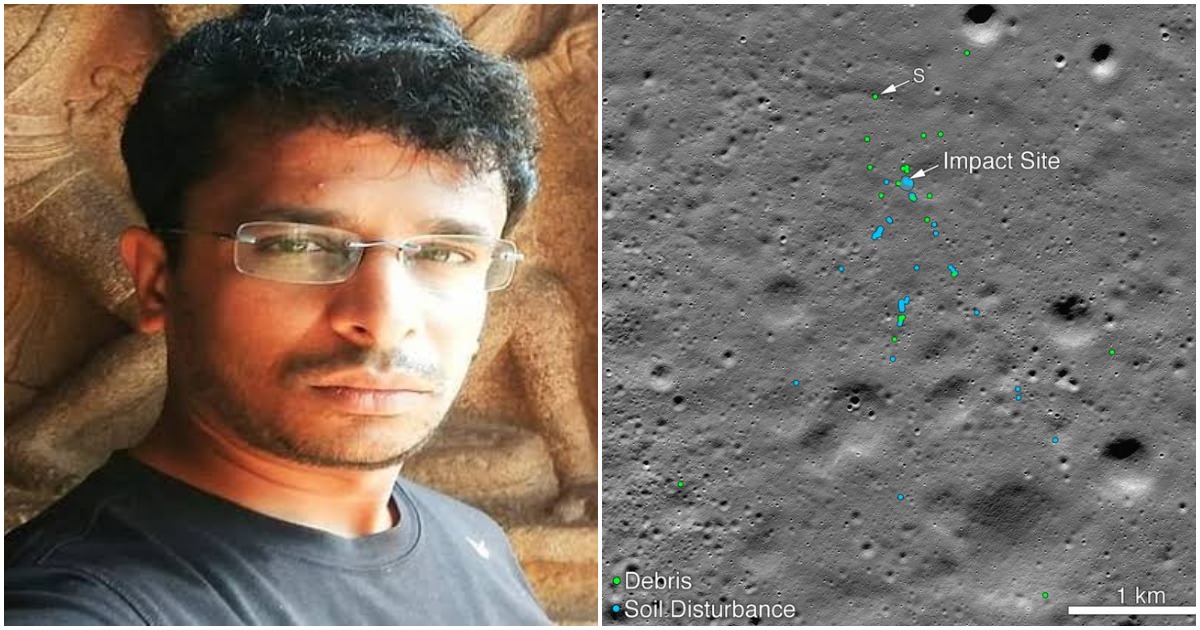Different international space agencies had tried different approaches to find ISRO’s lost lunar lander. ISRO had been using the Chandrayaan 2 that was orbiting around the moon to look for the lander. Nasa had used its deep space network antennas in California, Madrid and Canberra to send signals to the Vikram lander with the hope that it would reflect the signals if the lander’s systems were working. But one man beat them both to it — using only his laptop and an internet connection.
A Indian techie found ISRO’s lunar lander while working out of his home in Chennai. 33-year-old Shanmuga Subramanian, a mechanical engineer and a computer programmer who works as a technical architect at engineering company Lennox India Technology Centre in Chennai, has been credited by NASA for finding the missing Chandrayaan lander. Shanmuga, who hails from Madurai and had earlier worked for Cognizant as a programme analyst, used lunar images from Nasa’s Moon’s Lunar Reconnaissance Orbiter (LRO) captured on different dates (September 17, October 14, 15 and November 11) and studied them for weeks to locate the debris of the lander.
Subramanian had not only emailed NASA about his discovery, but had also been publicly tweeting about his findings. On 28th September, he’d tweeted an image with the caption, “If this not Vikram’s Lander then what is this? Is it an Alien Object?”.
If this not Vikram's Lander then what is this? Is it an Alien Ob ject? (From NASA's LRO Image)@LRO_NASA @NASA @NASAJPL #Chandrayaan2Landing #Chandrayaan2 #VikramLander #vikramlanderfound pic.twitter.com/Jp3TIiNxyw
— Shan (@Ramanean) September 28, 2019
@NASA @LRO_NASA @isro
This might be Vikram lander's crash site (Lat:-70.8552 Lon:21.71233 ) & the ejecta that was thrown out of it might have landed over here https://t.co/8uKZv7oXQa (The one on the left side was taken on July 16th & one on the right side was from Sept 17) pic.twitter.com/WNKOUy2mg1— Shan (@Ramanean) November 17, 2019
Subramanian told NDTV he worked for up to seven hours every day in his Chennai apartment in his mission to locate the lander using only his laptop. “I narrowed my search to 2 square kilometres. I used only a laptop and searched all the images,” he said. “I had side-by-side comparison of those two images on two of my laptops… on one side there was the old image, and another side there was the new image released by NASA,” he added.
Today morning, Subramanian’s efforts bore fruit. “Thank you for your email informing us of your discovery of debris from the Vikram lander. The LROC team confirmed that the location does exhibit changes in images taken before and after the date of the landing. Using the information, the LROC team did additional searches in this area and located the site of the primary impact as well as other debris around the impact location and has announced the sighting on the Nasa and ASU pages where you have been given credit for your observation,” Nasa’s deputy project scientist (LRO mission) John Keller wrote to him.
While announcing that it had found the lander, NASA acknowledged Shanmuga’s contribution in its press release. “Shanmuga Subramanian contacted the LRO project with a positive identification of debris. After receiving this tip, the LROC team confirmed the identification by comparing before and after images,” the press release said. In the image where NASA identifies the debris of the lander, the part that was discovered by the Indian techie was labeled S, after his initial. “”S” indicates debris identified by Shanmuga Subramanian,” wrote NASA.
The #Chandrayaan2 Vikram lander has been found by our @NASAMoon mission, the Lunar Reconnaissance Orbiter. See the first mosaic of the impact site https://t.co/GA3JspCNuh pic.twitter.com/jaW5a63sAf
— NASA (@NASA) December 2, 2019
While Subramanian has already earned his place in history — his Twitter bio has been updated to add “I found the Vikram Lander” — his discovery once again highlights how Indian jugaad can come up trumps against much more sophisticated techniques. NASA and ISRO had the space-age technology, the might of government aid, and thousands of employees, but were beaten to the punch by a man who assiduously went through thousands of pictures of the moon for seven hours every day on his personal laptop.
